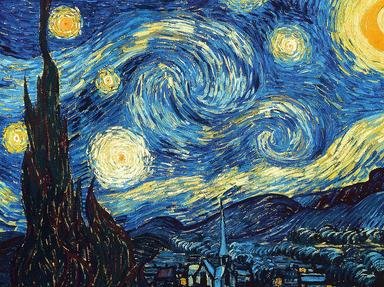Quiz Answer Key and Fun Facts
1. What better place to start than van Gogh's most famous work? Finished in 1889, "The Starry Night" was painted in a particular locale in Saint-Rémy-de-Provence in France. It depicts the view out of his window from which of these locations?
2. "The Potato Eaters" (1885), or "De Aardappeleters" in Dutch, is another of van Gogh's most famous works and his subjects for the painting were a family named the de Groots. Which of the following best describes the de Groots?
3. There are numerous van Gogh "Sunflowers" (1887-88) paintings, and the artist truly enjoyed painting them the most of all his works. The fourth version pictured here is likely the most famous. Art scientists have recently led studies into his pigments in these paintings as which of the following paints used by van Gogh has begun to fade rapidly?
4. Sure, the bedroom in van Gogh's painting "Bedroom in Arles" (1888) may look a little distorted with an odd perspective. But in fact, the real bedroom he was painting was not in the shape of a rectangle. What was its true shape?
5. Once calling it "one of the ugliest pictures I have done," Vincent van Gogh spent long nights at the Café de la Gare, a place for outcasts and drunks, to paint "The Night Café" (1888). What happened to the painting after he finished it?
6. "A Wheatfield with Cypresses" (1889) was believed to have been painted outdoors, or "en plein air." Van Gogh believed it to be his best summer painting, and in one instance, he wrote to his brother saying, "I have a canvas of cypresses with some ears of wheat, some poppies, a blue sky like a piece of ________." Which of these patterns did he compare the sky to?
7. Who was the subject of this 1890 portrait of whom Vincent van Gogh said, "I think that we must not count on __________ at all. First of all, he is sicker than I am, I think, or shall we say just as much, so that's that. Now when one blind man leads another blind man, don't they both fall into the ditch"?
8. Fascinated with Japanese works, van Gogh would study Japanese techniques by re-creating them in his own hand. Many art historians claim that "Irises" (1889) was one of van Gogh's attempts at what Japanese art form?
9. Vincent van Gogh's appreciation for Japanese art can be seen in this painting, "Self-Portrait with Bandaged Ear" (1889). If you focus on the right side of his head, you can see a print of a Japanese wood block in the background, though most people focus on the bandage on his ear. Why does it appear he injured his right ear, while in actuality he injured his left?
10. It is perhaps fitting that we return to a painting in which van Gogh has painted a scene with a starry night. In fact, it was the first painting he made with stars in a night sky. "Cafe Terrace at Night" (1888) depicts the Place du Forum in which French city, his home for around fourteen months?
Source: Author
trident
This quiz was reviewed by FunTrivia editor
ponycargirl before going online.
Any errors found in FunTrivia content are routinely corrected through our feedback system.
